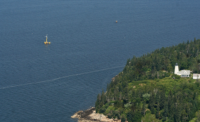Following the unveiling, the team disassembled the hull of the VolturnUS demonstrator. After transporting it to Cianbro’s Brewer facility, it will be assembled dockside, lifted upright and placed in the Penobscot River on May 31. Then, it will be towed to a site off the coast of Castine, south of Bangor, where it will be plugged into the grid on June 2 and launched in 75-ft-deep waters. In early July, the 300-ft, full-size unit will be launched off Monhegan Island, near Boothbay Harbor, in 250-ft-deep waters, where it will remain until hurricane season approaches.
For the prototype—dubbed VolturnUS after Vulturnus, the Roman god of the east wind—the export transmission cable will rest on the seabed only during the test period, Dagher said. “The full-scale-unit transmission line will likely be buried in most locations,” he said. Bangor-based Hampden Electric Inc. is the electrical subcontractor working with Cianbro to install the electric cable, he said.
This summer’s deployments will enable researchers to test the technology prior to the first full-scale grid hookup of a $96-million, 12-MW pilot farm with two-turbines, scheduled for 2016.
Cutting Cost of Installation
In Europe, siting offshore-wind power typically costs twice that of land-based generation. The DeepCwind Consortium's system is designed to be fully assembled dockside and launched from ports with 35-ft-deep waters. “VolturnUS is a true paradigm shift in offshore-wind technology,” Dagher said.
European turbine installation requires specialized vessels for deployment or jack-up barges that cost up to $300,000 a day. Instead, the Maine operation will use fabrication materials commonly available in many parts of the world and employ a 20-ton tugboat to tow the semisubmersible unit, Dagher said.
The design allows for four 25-year life cycles for the hull and the tower, Dagher said. “After each 25-year deployment, the VolturnUS is towed back to shore and the turbines are replaced.”
In December, the university and Norway-based Statoil each received $4 million in federal grants for their separate 12-MW deepwater floating-wind-turbine projects in Maine. Upon completion, each could receive up to $47 million over four years, if the U.S. Congress approves. In addition, the project has received $42.7 million in private investment.
In July, the university’s ASCC plans to begin construction of a new $6.5-million wind-wave testing and robotics manufacturing facility that will support development and commercialization of technology for offshore floating wind turbines.






Post a comment to this article
Report Abusive Comment